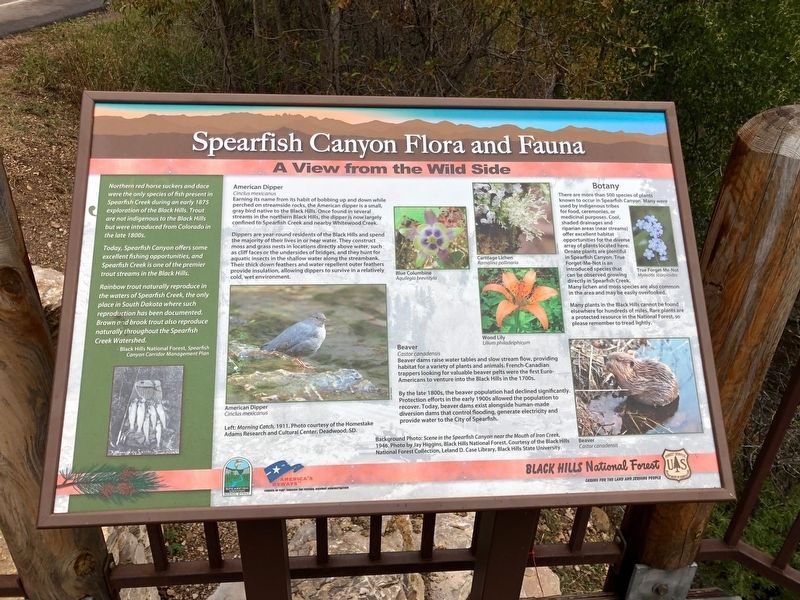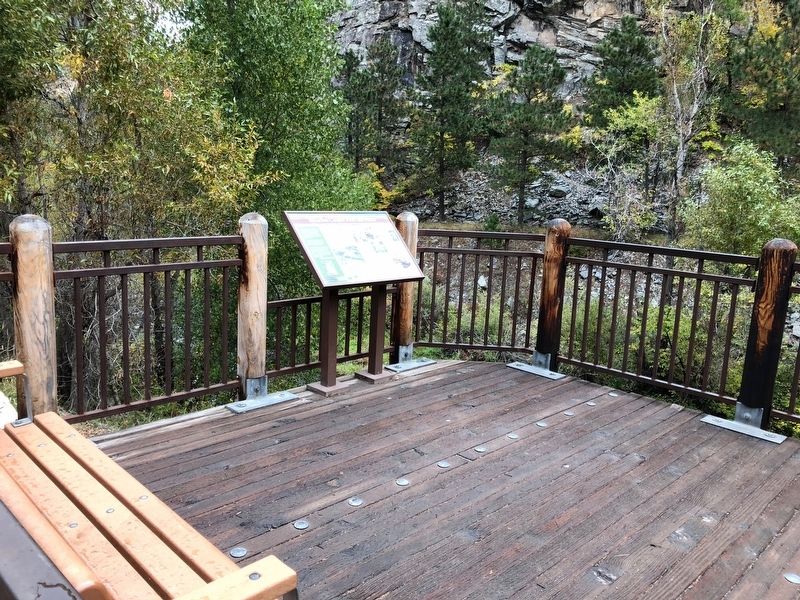Near Spearfish in Lawrence County, South Dakota — The American Midwest (Upper Plains)
Spearfish Canyon Flora and Fauna
A View from the Wild Side
Northern red horse suckers and dace were the only species of fish present in Spearfish Creek during an early 1875 exploration of the Black Hills. Trout are not indigenous to the Black Hills but were introduced from Colorado in the late 1800s.
Today, Spearfish Canyon offers some excellent fishing opportunities, and Spearfish Creek is one of the premier trout streams in the Black Hills.
Rainbow trout naturally reproduce in the waters of Spearfish Creek, the only place in South Dakota where such reproduction has been documented. Brown and brook trout also reproduce naturally throughout the Spearfish Creek Watershed.
Black Hills National Forest, Spearfish Canyon Corridor Management Plan.
American Dipper
Cinclus mexicanus
Earning its name from its habit of bobbing up and down while perched on streamside rocks, the American dipper is a small, gray bird native to the Black Hills. Once found in several streams in the norther Black Hills, the dipper is now largely confined to Spearfish Creek and nearby Whitewood Creek.
Dippers are year-round residents of the Black Hills and spend the majority of their lives in or near water.; they construct moss and grass nests in locations directly above water, such as cliff faces or the undersides of bridges, and they hunt for aquatic insects in the shallow water along the streambank. Their thick down feathers and water repellent outer feathers provide insulation, allowing dippers to survive in a relatively cold, wet environment.
Beaver
Castar canadensis
Beaver dams raise water tables and slow stream flow, providing habitat for a variety of plants and animals. French-Canadian trappers looking for valuable beaver pelts were the first Euro-Americans to venture into the Black Hills in the 1700s.
By the late 1800s, the beaver population had declined significantly. Protection efforts in the early 1900s allowed the population to recover. Today, beaver dams exist alongside human-made diversion dams that control flooding, generate electricity and provide water to the city of Spearfish.
Botany
There are more than 500 species of plants known to occur in Spearfish Canyon. Many were used by indigenous tribes for food, ceremonies, or medicinal purposes. Cool, shaded drainages and riparian areas (near streams) offer excellent habitat opportunities for the diverse array of plants located here. Ornate plants are plentiful in Spearfish Canyon. True Forget-Me-Not is an introduced species that can be observed growing directly in Spearfish Creek. Many lichen and moss species are also common in the area and may be easily overlooked. Many plants in the Black Hills cannot be found elsewhere for hundreds of miles. Rare plants are a protected resource in the National Forest, so please remember to tread lightly.
(Photo Captions)
Left: Morning Catch, 1911. Photo courtesy of the Homestake Adams Research and Cultural Center, Deadwood, SD.
Background Photo: Scene in the Spearfish Canyon near the Mouth of Iron Creek 1946. Photo by jay Higgins, Black Hills National Forest. Courtesy of the Black Hills National Forest Collection, Leland D. Case Library, Black Hills State University.
Topics. This historical marker is listed in these topic lists: Animals • Environment • Horticulture & Forestry. A significant historical year for this entry is 1875.
Location. 44° 24.988′ N, 103° 52.858′ W. Marker is near Spearfish, South Dakota, in Lawrence County. Marker is on Spearfish Canyon Highway (U.S. 14A) 6 miles Business 90, on the left when traveling south. Touch for map. Marker is in this post office area: Spearfish SD 57783, United States of America. Touch for directions.
Other nearby markers. At least 8 other markers are within 7 miles of this marker, measured as the crow flies. Spearfish Canyon Through Time (here, next to this marker); Thoen Stone (approx. 4.6 miles away); a different marker also named Thoen Stone (approx. 4.6 miles away); Civilian Conservation Corps Camp (approx. 5 miles away); The Mail (approx. 5.2 miles away); Center of the Country (approx. 6.1 miles away); Theodore Roosevelt “The American” (approx. 6.1 miles away); Mount Roosevelt (approx. 6.1 miles away). Touch for a list and map of all markers in Spearfish.
Credits. This page was last revised on October 5, 2018. It was originally submitted on October 2, 2018, by Ruth VanSteenwyk of Aberdeen, South Dakota. This page has been viewed 219 times since then and 25 times this year. Photos: 1, 2. submitted on October 2, 2018, by Ruth VanSteenwyk of Aberdeen, South Dakota. • Bill Pfingsten was the editor who published this page.

